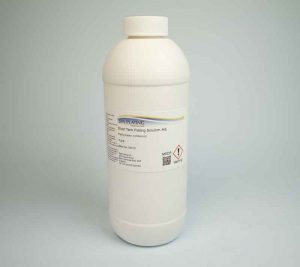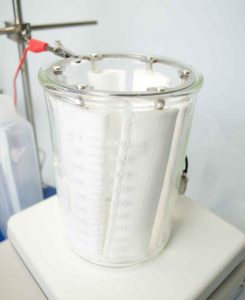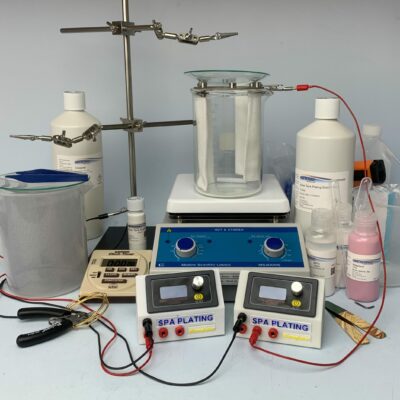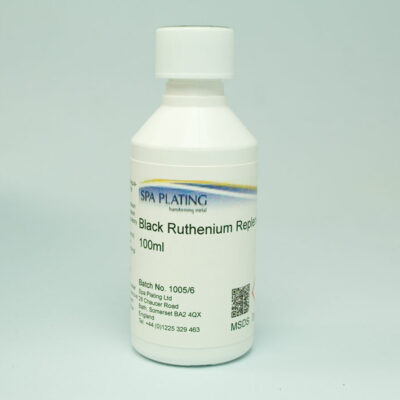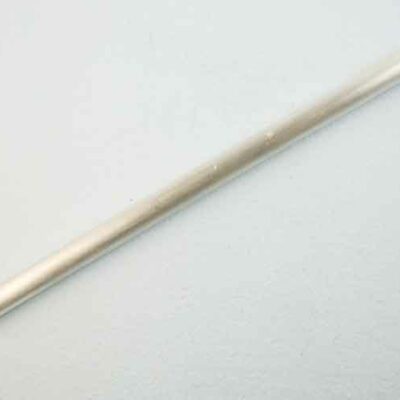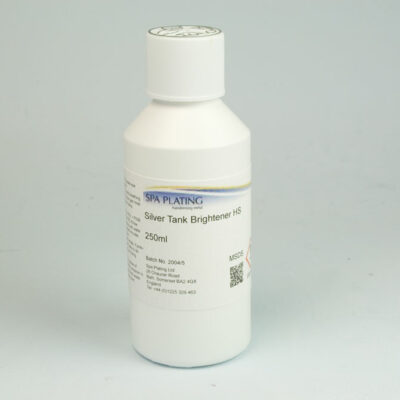Our Silver Tank Plating Solution – HS plates fast and bright with little to no requirement for polishing back. To keep your silver solution bright and shiny, you will need to use Silver Tank Brightener HS as per the online calculator. Cyanide free.
The pH of this solution need to be controlled with Silver pH Adjuster which cannot be shipped outside the UK and the EU.
HS Code: 3824 99 70
Silver Tank Plating Solution – HS
| Features |
Benefits |
| Designed to be used with our electrode ring fitted with silver electrodes. |
Plates fast – up to 0.6 microns per minute. This means you can build substantial thicknesses quickly. |
| No yellowing of deposit after rinsing. |
Greatly reduces the need for post plating polishing – particularly important if you’re plating very delicate or complexly shaped items. |
| The silver from the silver electrodes replenishes the silver plated out from the solution. |
Makes the Silver Tank Plating Solution – HS long life, which means you buy less solution in the long run. |
To get the best out of the Silver Tank Plating Solution – HS you need to heat it to 50 degrees centigrade with moderate agitation. Immersing the plated item in water at 60-70 degrees centigrade for 1-2 mins immediately after plating greatly helps the solution’s anti-tarnish properties.
Silver Tank Plating HS Tank Calculator
How to use this calculator :
1. In the first box, enter the thickness that you want to plate to in microns (thousandths of a millimetre).
2. In the second box, enter the surface area of the article in square centimetres (cm2).
3. Click the ‘Calculate’ button.
4. Read off the amp setting for your rectifier, the plating time and the volume of replenisher to add before starting the plating sequence.
6. If you are using our Coulometer or MicroPlater, read off the coulombs or in the case of the MicroPlater, the amp-hours.
5. The weight of silver plated is shown in the final box.
Operating Conditions and Deposit Data
| Plating Factor |
0.01A/cm2 (see notes) |
| Plating rate |
0.6 micron per minute (see notes) |
| Temperature |
45 – 55 centigrade 55 optimum (see notes) |
| Silver concentration in solution |
20 g/l |
| pH |
9.0 – 10.0 (see notes) |
| Agitation |
Stirrer |
| Electrodes |
Silver |
| Silver content in plate |
99.9 (Balance sulphur, nitrogen) |
| Cathode efficiency |
100% |
| Hardness |
110 – 120 Hv |
| Density of deposit |
10.4 g/cm3 |
| Stress |
Medium stress (tensile) |
| Special storage instructions |
Away from sunlight |
| Shelf life |
2 – 3 years |
| Health and safety classification |
Harmful (ingestion), Irritant (skin,eye) |
| Special considerations |
None |
| Transport (UN number) |
None: Not classified as dangerous for transport |
Notes:
- A flash coat of gold is necessary when beaker/tank plating on brass, copper and nickel.
- A gold strike is necessary when beaker/tank plating on stainless steel.
- Plating rate can be increased to 1 micron/minute especially for articles with smooth edges.
For higher plating speeds, an increase in agitation may be necessary. Refer
to further note below.
- Maximum thickness is around 10 microns.
- Adjust up if necessary with Silver pH adjuster.
- A dull coating can indicate the current is too low. Increasing the current in roughly
small increments can brighten the deposit. This solution is transparent and is
possible to view the deposition process while plating.
- Increasing the agitation too much can free particulate contamination from the
anode bags giving rise to rough deposits.
- Occasional carbon treatment may be necessary especially after being left idle
for a period of months.
- Brightness increases towards the lower end of the temperature range especially with
solutions that have remained idle for extended periods of time and freshly carbon-treated
solutions.
General guide;
Certain small items, for example Swabs, Nibs and Plating Pens can be sent by normal post within the UK
- The courier option for UK deliveries is FedEx
- Free UK mainland delivery available on orders over £200
- International orders usually 3-5 working days.
For all price quotations for deliveries, please add your items to our shopping cart. You will be able to see the shipping costs by clicking on the ‘Calculate shipping’ button in the cart and before checking out.
Please click on the link below to download the SDS for this product:
https://goldn.b-cdn.net/msds/silver_tank_plating_solution_hs.pdf

